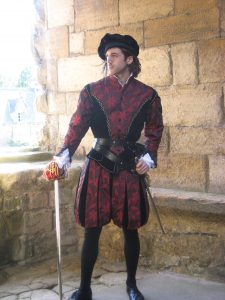




The following information refers to men of high rank.
Until boys reached the age of between 5 to 7, they wore skirts. They could still be indentified as boys and not girls as they wore hats that were a smaller version of the adult males’ and if of noble birth carried small swords. Sometimes their upper half was clothed in doublets again similar in style to an adult man.
Once “breeched”, they wore clothes similar to that of adult males.
Underwear amounted to a shirt! It was made of linen and reached to at least mid thigh. The side seams were left partly open so that the shirt could be tucked between the legs acting as pants.
A man was expected to wear a clean shirt every day.
The shirt might not be seen at all. Some shirts had frills at the neck and cuffs. Very high ranking men would have lace trimmings on the neck and
Men did not talk about wearing breeches. Breeches were called hose (sometimes trunk hose); stockings were called nether hose.
Hose in the earlier part of the 16th century were joined on to the nether hose by ties but by the mid 16th century, they are separate. The nether hose were kept up with garters tied under the hose so they couldn’t be seen.
Before hose, men work long tunics and any form of covering of the crotch was not required. Once hose became the thing to wear it was necessary to find someway of protecting oneself from constant exposure! The original cover was a triangular piece of cloth – the point was stitched to the hose and the other 2 corners fastened to the doublet so that it could be removed easily. This flap gradually became more padded and eventually became the codpiece.
Showing off one’s masculinity in the 16th century was important and was associated with ideas of chivalry, honour and romance. The codpiece became the way to cover all of this very effectively.
Sometimes men even gave their codpieces a name!
They were popular across Europe.

Here you can see the effect of slashed sleeves
This was fitted and worn over the shirt.
Sometimes the sleeves were “slashed”- this is when 2 types of material are used – the main fabric is cut in such a way to make it look like silk or satin linings were emerging from the sleeve.

Short cloak – velvet trimmed with silk and decorated with thread of gold
The cloak was worn over one shoulder and occasionally both. It varied in design and length and was usually decorative.
They were flat and looked a bit like the slipper of today. Boots were worn by soldiers and for riding only. They were not worn for walking about.
These were worn for warmth but also sometimes carried as a decorative accessory. Gloves were often given as gifts symbolising the hand of friendship.
They did have a practical use for keeping warm but at court they are mainly decorative. They were worn so that the face could be seen, to do otherwise gave the man a threatening appearance which was not acceptable at court.
Velvet was considered a high status material and feathers were also regarded as only suitable for the highest of ranks, therefore such hats were usually only seen at court.
When the hat was removed, a man would always hold it with the inside of it towards him. To hold a hat with the inside showing suggested that the man was begging, and no one wanted to see the sweaty head band either.

The sword was always carried in the right hand.
All men of rank carried a sword. They wore it at court and even when they were dancing. The sword was worn on the left side of the body and drawn by the right hand as this was the side of honour. Left handed people were never trusted in the 16th century. The left of the body was associated with evil, for it was on the left shoulder that the devil sat and whispered into the ear all kinds of wicked things. However, the guardian angel sat on the right shoulder and protected the individual.
For men this was more of a personal preference. Men wore rings and earrings but many did not. For high ranking men the costume could be enough. The clothes might have jewels stitched into them.
Buttons revolutionised clothes for men. Garments no longer needed to be made loose to fit over the head. Clothes could become tighter and more fitted.
Prior to the widespread use of buttons in the medieval period, ties were used to keep clothing together but there was less scope for any kind of design.
Hooks and eyes were also used made from brass or steel and were almost identical to modern ones.
The only fabric likely to be Scottish would be the linen for the shirt. Everything else would come from Italy, France or Flanders.
By Jackie Lee, Director of Artemis Scotland